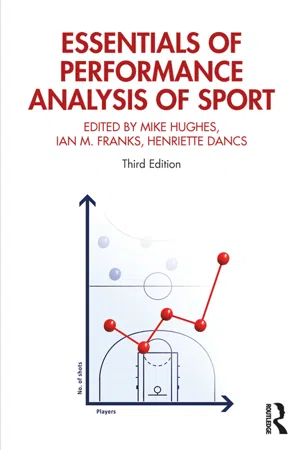
Essentials of Performance Analysis in Sport
Third edition
- 462 pages
- English
- ePUB (mobile friendly)
- Available on iOS & Android
Essentials of Performance Analysis in Sport
Third edition
About this book
The coaching process is about enhancing performance by providing feedback about the performance to the athlete or team. Researchers have shown that human observation and memory are not reliable enough to provide accurate and objective information for high-performance athletes. Objective measuring tools are necessary to enable the feedback process. These can take the form of video analysis systems post-event, both biomechanical and computerised notation systems, or the use of in-event systems.
Essentials of Performance Analysis in Sport 3rd Edition is fully revised with updated existing chapters and the addition of 12 new chapters. It is a comprehensive and authoritative guide to this core discipline of contemporary sport science. The book offers a full description of the fundamental theory of match and performance analysis, using real-world illustrative examples and data throughout. It also explores the applied contexts in which analysis can have a significant influence on performance. To this end the book has been defined by five sections.
In Section 1 the background of performance analysis is explained and Section 2 discusses methodologies used in notating sport performance. Current issues of performance analysis applied research, such as chance, momentum theory, perturbations and dynamic systems are explored in Section 3. Profiling, the essential output skill in performance analysis, is examined in depth in Section 4. The book's final section offers invaluable applied information on careers available for performance analysts.
With extended coverage of contemporary issues in performance analysis and contributions from leading performance analysis researchers and practitioners, Essentials of Performance Analysis in Sport 3rd Edition is a complete textbook for any performance analysis course, as well as an invaluable reference for sport science or sport coaching students and researchers, and any coach, analyst or athlete looking to develop their professional insight.
Frequently asked questions
- Essential is ideal for learners and professionals who enjoy exploring a wide range of subjects. Access the Essential Library with 800,000+ trusted titles and best-sellers across business, personal growth, and the humanities. Includes unlimited reading time and Standard Read Aloud voice.
- Complete: Perfect for advanced learners and researchers needing full, unrestricted access. Unlock 1.4M+ books across hundreds of subjects, including academic and specialized titles. The Complete Plan also includes advanced features like Premium Read Aloud and Research Assistant.
Please note we cannot support devices running on iOS 13 and Android 7 or earlier. Learn more about using the app.
Information
21Performance Profiling
21.1 Processes in Creating Performance Profiles
21.1.1 Performance Indicators

Table of contents
- Cover
- Half Title
- Title Page
- Copyright Page
- Contents
- Figures
- Tables
- About the Editors
- About the Contributors
- Section I The Background
- Section II The Methodology of Notational Analysis
- Section III Current Issues of Performance Analysis
- Section IV Profiling in Sport with Examples
- Section V Careers in Performance Analysis
- References and Bibliography
- Index